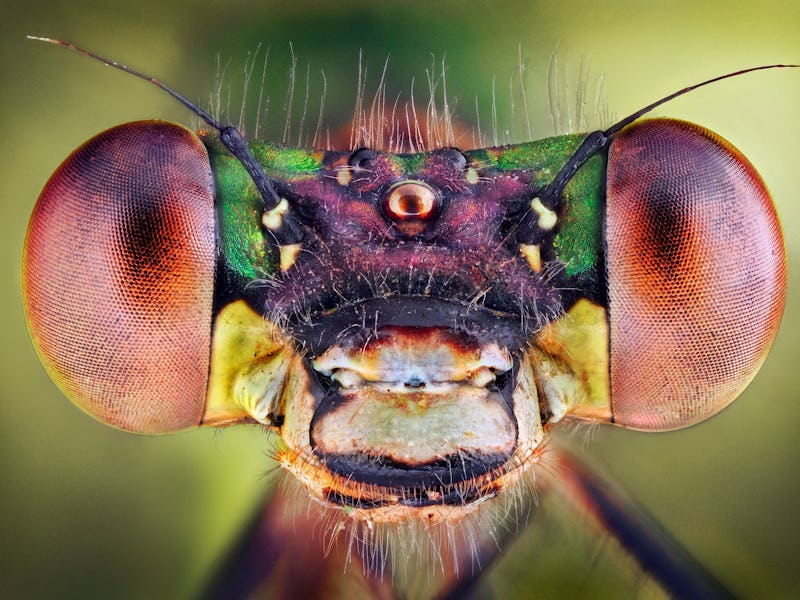Incredibly ancient fossil reveals controversial origins of a vital behavior
A fossil found in France is both an answer and a clue.

We may be fascinated by the glowing aura of fireflies gently lighting up a summer evening — but their flashing lights aren’t for us.
Instead, these bright bursts are a form of communication. Other insects communicate too and do so through various ways — rubbing wings together, for example, or vibrating their abdomens. Scientists think some even communicate through different dialects.
According to research on a newly discovered insect fossil, this ability to communicate began millions of years ago.
Etched into ancient rock, scientists think they’ve identified the oldest, and perhaps most unique, form of insect communication. They published their findings on Thursday in the journal Nature.
“We have an insect with a very different 'tool' to communicate — and much older,” study co-author André Nel, a professor at the National Museum of Natural History in France, tells Inverse.
It’s approximated to be 310 million years old. It lived during a time of mammal-like reptiles and before the dinosaurs.
What’s new — The previous oldest example of wing-based communication among insects was from the Middle Permian and found in southern France, Nel says. The Middle Permian period marked the end of the Paleozoic era, roughly 251 to 299 million years ago.
A close-up of the wings of the newly discovered insect Theiatitan azari.
Nel and colleagues also found their fossil in France — a grasshopper-like insect from the Titanoptera order. They describe Titanoptera insects in the study as an “order of probably carnivorous ‘giant’ insects,” with wingspans exceeding 12 inches.
This discovery, in turn, provides the “oldest record of wing communication in insects,” the study team writes. It is 50 million years older than the next oldest Titanoptera insect fossil and dates to the Carboniferous period.
The research team dubbed the newly discovered insect Theiatitan azari, paying homage to the Greek goddess of light, Theia. It’s a cheeky reference to one of the ways this ancient insect likely communicated with its swarm: through flashing light.
But here’s where it gets complicated — Previous studies suggested that insects of the Titanoptera order used a “communication tool on their forewing” much like living crickets, according to Nel.
However, the findings in this study challenge that previously assumed hypothesis.
This hypothesis relies on the assumption that both crickets and the ancient Titanoptera insects use something known as a “file” to communicate, producing sounds when the insect’s forewings move against each other.
Nel and colleagues argue their Titanoptera lacks this file, so it couldn’t produce sound in the same way as crickets. So, how then did Theiatitan azari communicate?
How they made the discovery — To resolve this communication conundrum, the team turned to a unique part of the insect, which they learned about through their fossil discovery: the special, enlarged areas on the wings of Theiatitan azari.
An analysis of these broadened areas on the wings of the newly discovered insect prompted two hypotheses for how the ancient insect communicated:
- Through crepitation: The insect suddenly broadens its wings when taking flight, producing sounds to communicate with other insects
- Through light communication: The insect repeatedly flashes light toward predators or prey using reflections from its wings.
The study team reasons both hypotheses are mutually compatible and are probable ways the ancient insect communicated with allies and enemies. This also suggests “sound and/or light communication is a very old phenomenon,” write the researchers.
How did ancient insects use their wings to communicate? Scientists attempt to answer this question in a new study.
Why it matters — By understanding how ancient insects communicate, we can learn more about the prey they were feeding on and the predators they were trying to escape.
“This discovery shows how complex ecosystems were during the late Carboniferous, with enough predators to 'oblige' some insects to develop complex strategies to communicate —either to escape predators or for inter-sex communication,” Nel says.
These findings aren’t just for paleontologists, Nel argues, reasoning they are relevant to our modern-day insect ecosystem. The fossil, and its analysis, reveals a striking similarity between ancient creatures and modern-day insects — a similarity previous unknown until now.
“We were surprised to find so ancient insects that could produce flashes of light — a character present in several very 'modern' insect groups, but until now unknown for the Palaeozoic or Triassic insects,” Nel says.
What’s next — In future studies, the team wants to search for sensory receptors in Titanoptera’s eyes that could detect flash signals, as well as specialized tympanal organs once capable of detecting variations in air pressure.
The presence of these receptors and organs could help confirm the flashing and crepitation hypotheses.
Until then, we can relish in the fact that we know a little bit more about how insects came to communicate — and eventually swarm the planet.
Abstract: Acoustic communication is well-known in insects since the Mesozoic, but earlier evidence of this behavior is rare. Titanoptera, an‘orthopteroid’Permian-Triassic order, is one of the few candidates for Paleozoic intersex calling interactions: some specimens had highly specialized broadened zones on the forewings, which are currently considered—despite inconclusive evidence—as resonators of a stridulatory apparatus. Here we argue that the stridulatory apparatus hypothesis is unlikely because the Titanoptera lack a stridulatory file on their bodies, legs or wings. Instead, comparing these broadened zones with similar structures in extant locusts, flies, and fossil damselflies, we find evidence that the Titanoptera used their wings to produce flashes of light and/or crepitated sounds. Moreover, we describe the first carboniferous (~310 Mya) Titanoptera, which exhibits such specialized zones, thus corresponding to the oldest record of wing communication in insects. Whether these communication systems were used to attract sexual partners and/or escape predators remain to be demonstrated.